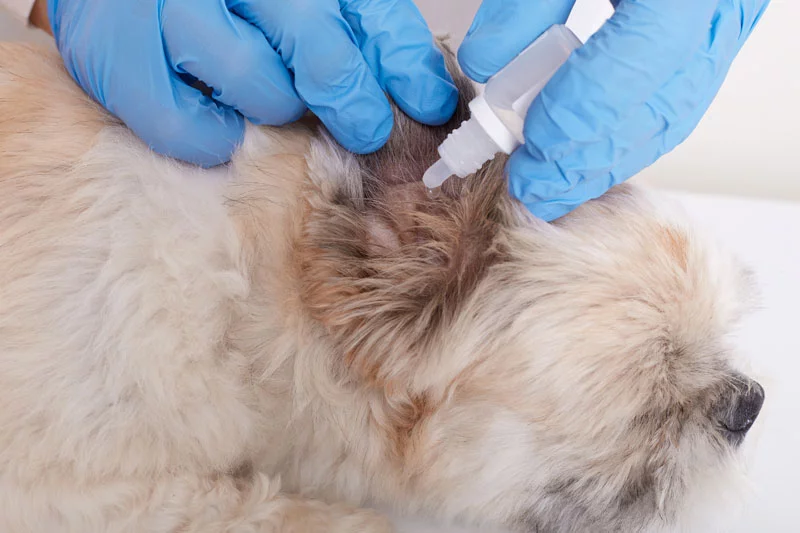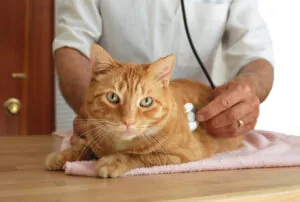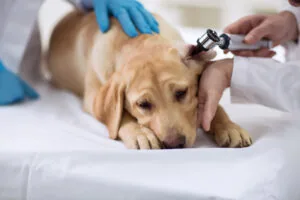Ear Infections in Dogs (Otitis Externa)

What is Otitis Externa?
Otitis is a term that describes inflammation of the ear. Inflammation can affect both the skin of the ear flap (pinna) and also the skin lining the ear canals. The ear canals of dogs and cats are open to the outside world at the base of the ear flaps, and are L-shaped skin-lined tubes that extend down to a semi-transparent membrane called the tympanic membrane.
How common are ear infections in dogs?
Infection of the external ear canal (outer ear infection) is called otitis externa and is one of the most common types of infections seen in dogs. Some breeds, particularly those with large, floppy or hairy ears like Cocker Spaniels, Miniature Poodles, or Old English Sheepdogs, appear to be more prone to ear infections, but ear infections may occur in any breed.
Symptoms
The most common symptoms of otitis externa and otitis media are pain, head shaking, scratching at the external ear flaps, and bad odor. In a physical examination by a veterinarian, a dog with the condition may exhibit redness and swelling of the external ear canal, scaling skin or obstruction of the ear canal. Signs such as tilting the head, anorexia, incoordination, and occasional vomiting may indicate the development of otitis media, or otitis interna, if the infection and inflammation spreads to the inner ear.
Causes
Otitis externa and otitis media can be caused by a variety of things. The primary causes are parasites, food allergies, drug reactions, foreign bodies (e.g., plant awns), accumulation of hair, dead skin buildup (keratinization), and autoimmune diseases. Other factors that may contribute to the onset of the inflammatory conditions include bacterial infections, mixed infections caused by bacteria and fungal species, and progressive changes in the environment of the outer ear canal. Excessive moisture caused by swimming, or overzealous, abrasive, and improper ear cleaning may also lead to otitis externa and otitis media.
Diagnosis
X-rays may be used to diagnose otitis media; an magnetic resonance imaging (MRI) may also be used to identify an accumulation of fluid or soft tissue growth in the middle ear. Other ways of diagnosing these conditions include skin scrapings from the dog’s ear flaps to test for parasites, and skin biopsies to check for autoimmune diseases. However, the single most important tool for diagnosing otitis externa and otitis media is a microscopic examination of the ear discharge (aural exudate).
Treatment
Treatment for otitis externa and otitis media usually involves outpatient care, unless the inflammation or infection has moved into the inner ear. In most cases of otitis externa, a topical therapy following a complete cleansing of the external ear is an effective resolution to the problem. The topical therapy may consist of antibacterial, corticosteroid, anti-yeast, and antiseptic drops. In severe cases of otitis externa and otitis media — where the presence of infectious organisms has been confirmed — oral antibiotics and antifungals may be prescribed. Corticosteroids may also be used to reduce the animal’s pain and swelling.
Is there anything I need to know about administering medication in the ear?
It is important to get the medication into the horizontal part of the ear canal. Unlike our ear canal, the dog’s external ear canal is L-shaped. The vertical canal connects with the outside of the ear and is the upper part of the ‘L’. The horizontal canal lies deeper in the canal and terminates at the eardrum. The goal is to administer the medication into the lower part of the ‘L’ – the horizontal ear canal.
The ear canal may be medicated by following these steps:
- Gently pull the earflap straight up and slightly toward the back and hold it with one hand.
- Using the other hand, apply a small amount of medication into the vertical part of the ear canal while continuing to keep the earflap elevated. Hold the ear up long enough for the medication to run down to the turn between the vertical and horizontal canal.
- Put one finger in front of and at the base of the earflap, and put your thumb behind and at the base.
- Massage the ear canal between your finger and thumb. A ‘squishing’ sound tells you that the medication has gone into the horizontal canal.
- Release the ear and let your dog shake its head. Many medications will contain a wax solvent and you may observe debris dissolved in this solvent leaving the ear as your dog shakes its head.
- If a second medication is to be used, apply it in the same manner. Typically, you should wait 5-30 minutes before applying additional medications. Be sure to ask your veterinarian for specific directions regarding any ear medication or cleansing agents.
- When all medications have been applied, clean the outer part of the ear canal and the inside of the earflap with a cotton ball soaked in some of the medication. Do not use cotton tipped applicators (Q-Tips) to do this, as they tend to push debris back into the vertical ear canal.
Otitis externa in dogs is common and, in many, it can become a recurring problem. With time, the pathological changes to the ear canals will become irreversible; in these cases, the best alternative treatment is total ear canal ablation. To avoid this outcome, an understanding of the normal physiology and how to restore it by reversing the pathophysiological changes within the ear is paramount to successful long-term management.
Living and Management
Follow-up treatments for otitis externa and otitis media involve repeat examinations of the ear discharge and control of any underlying diseases. You may be asked to routinely cleanse the dog’s ear to prevent a recurrence. With the proper therapy, most cases of otitis externa will resolve within three to four weeks, whereas otitis media takes a considerably longer amount of time to treat it, and up to six weeks to be resolved. If these conditions persist over long periods of time, and are not treated, they may lead to deafness, facial nerve paralysis, otitis interna, and (rarely) meningoencephalitis.
Ear infections can be especially frustrating as they have the ability to draw out for months, even years, even with the best of treatment. It is important to have a logical approach, to know what sort of infection is in the ear, to do proper home care regularly, and to have regular recheck appointments.
Share This Post
Recent Posts
About Shallowford Animal Hospital
Shallowford Animal Hospital and The Pet Spa at Shallowford are dedicated to the exceptional, compassionate care your pet deserves. Pets hold a very special place in our families, and we treat yours like our own.



